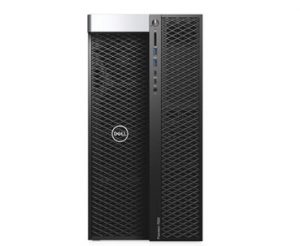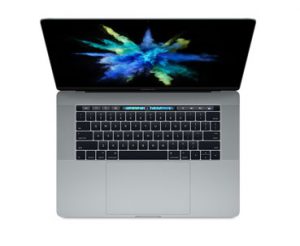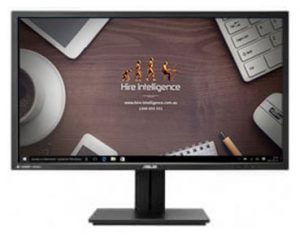Graphic design is one of the most powerful and effective tools that a brand can use for communicating with their customers. These days, designers use a continuously evolving range of software to create the dramatic designs and informational images they need to get their message across.
For that advanced software to work to best effect, you need a desktop or laptop for designers that’s up to the task! In this post, we’ll highlight the components and prime specifications that good laptops and PCs for graphic design all share.
Firstly, laptop or desktop PC for graphic design?
In essence, the features that you need from your computer, as well as your budget, will dictate whether you get a laptop or desktop.
If your work involves a lot of travelling, a laptop is the natural choice. However, remember that you can always attach an external monitor to your laptop at your permanent workstation, to give you a more desktop-like experience.
Below we run through some of the pros and cons of each.
Laptops vs desktops for designers
Laptops for graphic design
Pros:
- The biggest advantage of a laptop is always its portability, and the fact that you can use it virtually everywhere.
- Most laptop computers come with built-in Bluetooth and Wi-Fi connectivity.
Cons:
- There is a limit to the size of the screen. If the screens get too big, it affects the laptop’s portability.
- Heat dissipation can be a problem, so laptop components tend to not run as fast as desktop components.
- Laptops are typically less easily upgradable than PCs.
- Less longevity than a desktop, as a laptop typically will need to be replaced every 4 – 5 years.
Desktop PCs for graphic design
Pros:
- Desktops are often easier to configure according to your requirements as regards the choice of storage, RAM capacity, GPU, etc.
- Desktops tend to have more powerful CPUs, so you can run more heavy-duty software. Laptop GPUs typically have a speed of 70 – 80% of desktop GPUs or graphics cards.
- Because it’s easier to replace failing or inadequate components in a desktop, they tend to have more longevity.
- Desktops allow you to select any monitor, keyboard, speakers, and other peripherals as you please.
- Desktops are harder to steal, which is important if you work with sensitive client information.
- Desktops are generally more ‘budget-friendly’ and give you more power for your money.
Cons:
- Desktops are not portable! With all their separate components, they can be problematic to move.
- They tend to be noisier because of their cooling fans.
- They offer a less unified system as they are comprised of different components. This could pose an issue as regards the number of power points required.
- A desktop configuration with its added peripherals uses more electricity than a laptop.
- Ideally, a desktop should always be connected with a UPS outlet to provide a safe and stable power source.
What about an all in one PC for graphic design?
Recently, a new contender has come along – the all-in-one PC. Because these combine tower and monitor, they offer an option somewhere between the two – more portable than a PC, but with a larger screen than a laptop.
Pros:
- An all-in-one PC saves on space (in comparison to a standard workstation) as all its components are integrated inside the monitor shell.
- Easier access to ports compared to a tower (where extra ports are normally situated in the back).
- Easier to move around as it’s one single unit.
- Some all in one PCs for graphic design use removable processors, which allows you to upgrade your CPU.
- May be simpler to use for people who are not particularly tech-savvy!
Cons:
- Harder to upgrade.
- The system might lag with very power-hungry programmes.
- They are typically quite expensive.
- With everything located on the motherboard, the whole motherboard has to be replaced if anything goes wrong.
- Most AIOs aren’t supported by their manufacturer beyond three years after release.
How to find the best laptop or desktop for graphic design
The primary specs you need to consider in laptops or desktops for creatives are the processor, RAM, screen, video card and storage space.
Processor / CPU
Unless you’re using the most basic software, graphic design generally demands a lot of muscle. You will, therefore, not just have to look at the speed, (given in GHz or gigahertz), but also the number of cores your processor has. Remember that generally, desktops tend to have more cores than a laptop of the same price.
If you want a good laptop for designers, it should be one with a quad core processor that will give you a minimum speed of 1 GHz.
If you’re working on 3D or high-resolution graphics, we’d recommend at least an Apple M1 or an Intel i7.
RAM
Most graphic design programmes will need at least a minimum of 8GB of RAM, though this does largely depend on the software you intend using. Adobe After Effects, for instance, needs 16GB. In a nutshell, it boils down to the more RAM, the better, as it will give you faster processing.
The best laptops for graphic designers normally come with 16GB RAM already preloaded, with a future option to upgrade should you need it. This is especially important if you want to use the laptop for animation, video, and 3D work.
We need to make an important point here – Windows laptops and desktops for designers are generally easier to upgrade than Apple devices. So, if you’re a hardcore macOS fan, it’s important that your laptop has enough RAM from the start.
Screen / Display
High-resolution screens are vital for graphic designers. They have to be able to see much more detail than is normally required for office applications or browsing. This means that you should be looking for a minimum resolution of 1920×1080 pixels, along with a screen size of at least 15 inches or bigger.
If, however, you need something smaller and more portable, why not pair a good notebook with a big, high-res external monitor? This will effectively give you the best of both worlds!
VRAM / GPU / discrete graphics card
If you need video random access memory for your work, a dedicated graphics card is essential. Note, however, that not all graphic design software needs this. However, the foremost programmes, like Photoshop, do require it. If you’re not sure, we suggest you go for at least 2GB VRAM, with 4GB being even more preferable.
Hard drive / Storage
Knowing you have plenty of storage space is always reassuring when you work with very bulky files. External hard drives may be adequate for finished projects. However, we’d strongly suggest at least 512 GB SSD, (solid state drive) or 750 GB HDD (hard disk drive) integral storage capacity on your laptop for current projects.
Operating system
As we pointed out earlier, upgrading individual components on Apple devices is rarely feasible. Therefore, Windows is your best option if you wish to build your own customised system as you go along.
Apart from that, almost all the best graphics programmes are compatible with both Windows and macOS. So, really, as operating systems go, you can please yourself!
In brief:
Good laptops and desktops for graphic design should tick all the following boxes:
- Processor – Apple M1, or Intel Core i7, or higher
- VRAM – at least 2GB, preferably more
- RAM: 16GB if you can, but a minimum of 8GB
- FullHD display (or higher) with a minimum resolution of 1920×1080 pixels
- 512GB + SSD hard drive space, preferably 1TB or more
Selecting the best laptop/PC for your graphic design software
Most creatives have a few favourite design programmes they do most of their work on, so it’s vital to check the developer’s recommended hardware specs when comparing graphic design desktops and/or laptops. We’ve highlighted the requirements of a few of the most popular graphic design suites below:
| Programme | RAM | GPU / VRAM | Disk Space | Screen Resolution |
| Adobe After Effects | 16 GB | 2 GB | 5 GB | 1280 x 1080 |
| Adobe Illustrator | 8 GB | Not Required | 2 GB | 1024 x 768 |
| Adobe Lightroom | 16 GB | 4 GB | 2 GB | 1920 x 1080 |
| Adobe Photoshop | 8 GB | 2 GB | 4 GB | 1920 x 1080 |
| Affinity Designer | 2 GB | Not Required | 934 MB | 1280 x 786 |
| Affinity Photo | 2 GB | Not Required | 953 MB | 1280 x 786 |
| CorelDraw | 2 GB | Not Required | 1 GB | 1280 x 720 |
| GIMP | 256 MB | Not Required | 200 MB | Not Specified |
| Inkscape | Not Specified | Not Required | 500 MB | Not Specified |
Remember, new versions of many of these apps come out regularly. These often have higher system requirements than the previous versions did.
To give you a head start, the best laptop for your graphic design work should effectively exceed all the stated minimum system requirement specs of your favourite design apps.
Hire Intelligence’s choice as the best PC for graphic design
Dell Precision T7910 20 Core Professional Workstation
If you want to run several graphic design programs and never worry about performance again, then this is the desktop for designers you’ve been waiting for!
- CPU: 2 x 10 Core Intel Xeon processors for 20 cores in total
- RAM: 32GB preloaded, upgradeable to a max of 128GB
- Storage: 256GB SSD and 1TB conventional HDD
- GPU: Nvidia Quadro M4000 8GB graphics adapter
Our choice as the best laptop for creatives
Apple Touchbar MacBook Pro 15
- Customisable colour touch bar unique to this range
- Powerful 2.8GHz i7 Quad Core CPU
- 16GB RAM and 2GB dedicated VRAM
- 15″ 2880×1800 pixel Retina Display suitable for even the most detailed graphics work
For even more vibrant detail, combine your MacBook or graphic design desktop with the incredible…
Asus PB287Q 28 Inch UHD 4K Monitor
- Ultra High Definition (UHD) 4K resolution (3840×2160 pixels)
- Handy Picture in Picture (PiP) and Picture by Picture (PbP) functions
- Fully height, tilt, and pivot adjustable stand, but can also be wall-mounted if you prefer
- HDMI, HDMI/MHL and DisplayPort inputs
Rent the best laptops and desktops for graphic design from Hire Intelligence
In the field of graphic design, having the latest and most advanced equipment really does make a world of difference. However, sad to say, that often impacts the price!
And therein lies the prime reason why hiring a graphic design laptop makes such eminent good sense. It not only makes your laptop affordable, but regularly upgrading it to take advantage of the newest tech is a doddle.
We can also customise your PC for graphic design for you, for example, if you want more RAM or a better graphics card. We offer a standard keyboard, mouse, and monitor with any desktop rental, but we do have snazzier external monitors if you want a full HD / 4K option.
Our rental contracts are flexible and hassle-free, and we supply you with ongoing technical support whenever you need it. You also benefit from our hard-won experience gained from decades in the field.
So why not take a good look at some of our amazing editing and design laptops, desktops, and monitors? Or get in touch with us now for a chat, advice, and personalised help.





